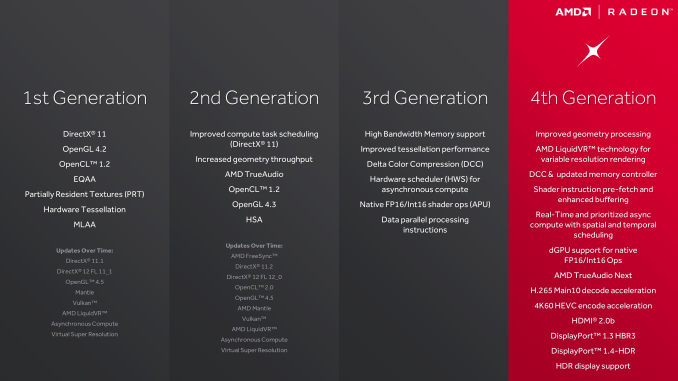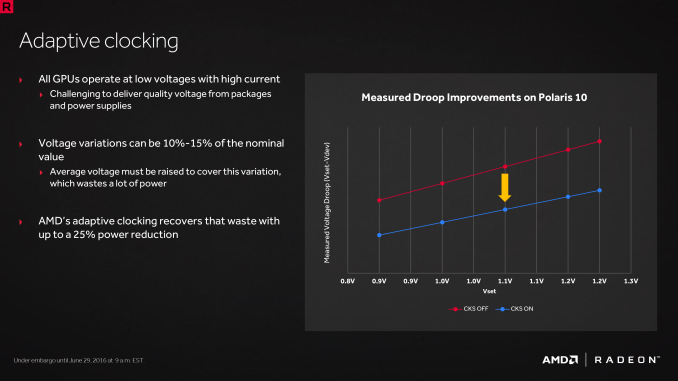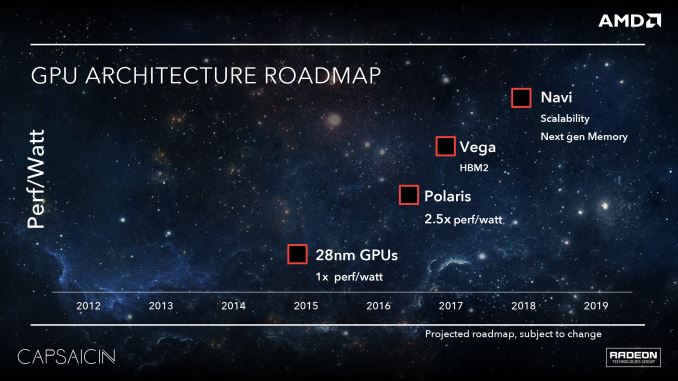The AMD Radeon RX 480 Preview: Polaris Makes Its Mainstream Mark
by Ryan Smith on June 29, 2016 9:00 AM ESTAMD's Path to Polaris
With the benefit of hindsight, I think in reflection that the 28nm generation started out better for AMD than it ended. The first Graphics Core Next card, Radeon HD 7970, had the advantage of launching more than a quarter before NVIDIA’s competing Kepler cards. And while AMD trailed in power efficiency from the start, at least for a time there they could compete for the top spot in the market with products such as the Radeon HD 7970 GHz Edition, before NVIDIA rolled out their largest Kepler GPUs.
However I think where things really went off of the rails for AMD was mid-cycle, in 2014, when NVIDIA unveiled the Maxwell architecture. Kepler was good, but Maxwell was great; NVIDIA further improved their architectural and energy efficiency (at times immensely so), and this put AMD on the back foot for the rest of the generation. AMD had performant parts from the bottom R7 360 right up to the top Fury X, but they were never in a position to catch Maxwell’s efficiency, a quality that proved to resonate with both reviewers and gamers.
The lessons of the 28nm generation were not lost on AMD. Graphics Core Next was a solid architecture and opened the door to AMD in a number of ways, but the Radeon brand does not exist in a vacuum, and it needs to compete with the more successful NVIDIA. At the same time AMD is nothing if not scrappy, and they can surprise us when we least expect it. But sometimes the only way to learn is the hard way, and for AMD I think the latter half of the 28nm generation was for the Radeon Technologies Group learning the hard way.
So what lessons did AMD learn for Polaris? First and foremost, power efficiency matters. It matters quite a lot in fact. Every vendor – be it AMD, Intel, or NVIDIA – will play up their strongest attributes. But power efficiency caught on with consumers, more so than any other “feature” in the 28nm generation. Though its importance in the desktop market is forum argument fodder to this day, power efficiency and overall performance are two sides of the same coin. There are practical limits for how much power can be dissipated in different card form factors, so the greater the efficiency, the greater the performance at a specific form factor. This aspect is even more important in the notebook space, where GPUs are at the mercy of limited cooling and there is a hard ceiling on heat dissipation.
As a result a significant amount of the work that has gone into Polaris has been into improving power efficiency. To be blunt, AMD has to be able to better compete with NVIDIA here, but AMD’s position is more nuanced than simply beating NVIDIA. AMD largely missed the boat on notebooks in the last generation, and they don’t want to repeat their mistakes. At the same time, starting now with an energy efficient architecture means that when they scale up and scale out with bigger and faster chips, they have a solid base to work from, and ultimately, more chances to achieve better performance.
The other lesson AMD learned for Polaris is that market share matters. This is not an end-user problem – AMD’s market share doesn’t change the performance or value of their cards – but we can’t talk about what led to Polaris without addressing it. AMD’s share of the consumer GPU market is about as low as it ever has been; this translates not only into weaker sales, but it undermines AMD’s position as a whole. Consumers are more likely to buy what’s safe, and OEMs aren’t much different, never mind the psychological aspects of the bandwagon effect.
Consequently, with Polaris AMD made the decision to start with the mainstream market and then work up from there, a significant departure from the traditional top-down GPU rollouts. This means developing chips like Polaris 10 and 11 first, targeting mainstream desktops and laptops, and letting the larger enthusiast class GPUs follow. The potential payoff for AMD here is that this is the opposite of what NVIDIA has done, and that means AMD gets to go after the high volume mainstream market first while NVIDIA builds down. Should everything go according to plan, then this gives AMD the opportunity to grow out their market share, and ultimately shore up their business.
As we dive into Polaris, its abilities, and its performance, it’s these two lessons we’ll see crop up time and time again, as these were some of the guiding lessons in Polaris’s design. AMD has taken the lessons of the 28nm generation to heart and have crafted a plan to move forward with the FinFET generation, charting a different, and hopefully more successful path.
Though with this talk of energy efficiency and mainstream GPUs, let’s be clear here: this isn’t AMD’s small die strategy reborn. AMD has already announced their Vega architecture, which will follow up on the work done by Polaris. Though not explicitly stated by AMD, it has been strongly hinted at that these are the higher performance chips that in past generations we’d see AMD launch with first, offering performance features such as HBM2. AMD will have to live with the fact that for the near future they have no shot at the performance crown – and the halo effect that comes with it – but with any luck, it will put AMD in a better position to strike at the high-end market once Vega’s time does come.













449 Comments
View All Comments
Flunk - Thursday, June 30, 2016 - link
The Crossfire reviews I've read have said the GTX 1070 is faster on average than RX 480 Crossfire, maybe you should go read those reviews.Murloc - Tuesday, July 5, 2016 - link
comparing crossfire/sli to a single gpu is really useless. Multigpu means lots of heat, noise, power consumption, driver and game support issues, and performance that is most certainly not doubled on many games.Most people want ONE video card and they're going to get the one with the best bang for buck.
R0H1T - Wednesday, June 29, 2016 - link
For $200 I'll take this over the massive cash grab i.e. FE obviously!Wreckage - Wednesday, June 29, 2016 - link
Going down with the ship eh? It took AMD 2 years to compete with the 970. I guess we will have to wait until 2018 to see what they have to go against the 1070looncraz - Wednesday, June 29, 2016 - link
Two years to compete with the 970?The 970's only advantage over AMD's similarly priced GPUs was power consumption. That advantage is now gone - and AMD is charging much less for that level of performance.
The RX480 is a solid GPU for mainstream 1080p gamers - i.e. the majority of the market. In fact, right now, it's the best GPU to buy under $300 by any metric (other than the cooler).
Better performance, better power consumption, more memory, more affordable, more up-to-date, etc...
stereopticon - Wednesday, June 29, 2016 - link
are you kidding me?! better power consumption?! its about the same as the 970... it used something like 13 lets watts while running crysis 3... if the gtx1060 ends up being as good this card for under 300 while consuming less watts i have no idea what AMD is gonna do. I was hoping for this to have a little more power (more along 980) to go inside my secondary rig.. but we will see how the 1060 performance.i still believe this is a good card for the money.. but the hype was definitely far greater than what the actual outcome was...
adamaxis - Wednesday, June 29, 2016 - link
Nvidia measures power consumption by average draw. AMD measures by max.These cards are not even remotely equal.
dragonsqrrl - Wednesday, June 29, 2016 - link
"Nvidia measures power consumption by average draw. AMD measures by max."That's completely false.
CiccioB - Friday, July 1, 2016 - link
Didn't you know that when using AMD HW the watt meter switches to "maximum mode" while when applying the probes on nvidia HW it switched to "average mode"?Ah, ignorance, what a funny thing it is
dragonsqrrl - Friday, July 8, 2016 - link
@CiccioBNo I didn't, source? Are you suggesting that the presence of AMD or Nvidia hardware in a system has some influence over metering hardware use to measure power consumption? What about total system power consumption from the wall?
At least in relation to advertised TDP, which is what my original comment was referring to, I know that what adamaxis said about avg and max power consumption is false.